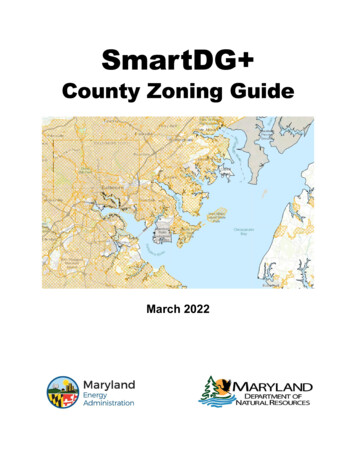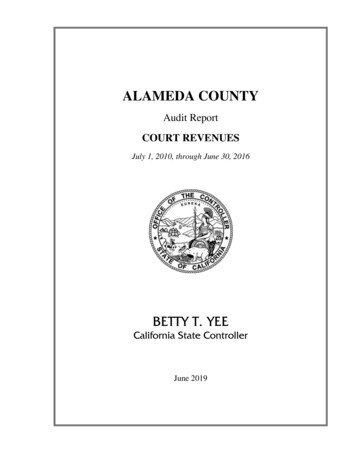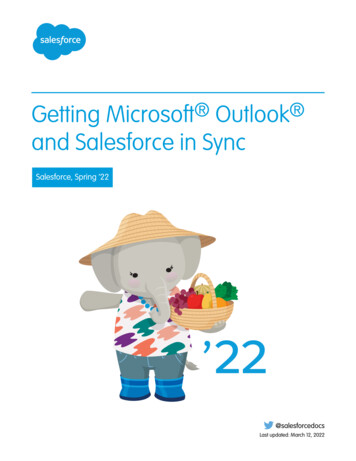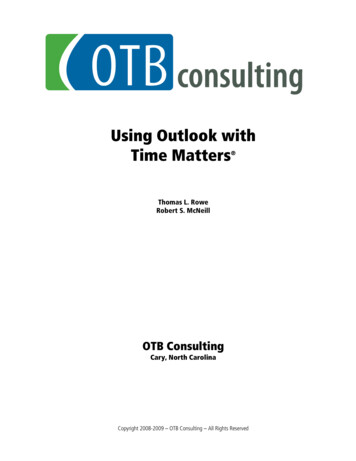
Transcription
36THOAKL AND COUNTYECONOMIC OUTLOOK20 2 1 -2 0 2 3
SUMMARY INTRODUCTIONDAVID COULTEROAKLAND COUNTY EXECUTIVETo a person, Oakland County demonstrated its resilience, collaborative spiritand innovation during these past 15 months, as we charted a course throughan unprecedented global pandemic. I am grateful that our Oakland Countyleaders and employees did not hesitate to answer the call and demonstratethe important role of local county government during these trying times.Our county is comprised of more than 1.2 million residents and 42,000businesses that generate more than 20 percent of Michigan’s grossdomestic product. Maintaining a healthy economy in Oakland County is notonly a key goal for us, but also provides an essential contribution to thefiscal well-being of the region and state.Oakland County received more than 257 million in funding from the federaland state governments to manage through the pandemic. My administrationalong with the County Board of Commissioners prioritized the aid anddistributed the funding with the largest portion dedicated to communities andfamilies; closely followed by funding for businesses and workers; and, finally, tosupport county COVID-19 operations.Oakland County leaned in to provide support to make certain our residents hadthe resources they needed to survive. Through funding to local municipalities,public schools, libraries, senior centers, veteran service organizations, andcommunity centers, we worked to ensure services and support systems wereaccessible virtually and/or in person. Emergency funds for rent, mortgage,utilities and food assistance also were made available to veterans and theirdependents, as well as citizens negatively impacted financially by COVID-19.Nearly 90 million in support was directed to the business community for thoseseriously impacted by the pandemic through a variety of initiatives, including: A series of five small business grant programs that provided direct financialsupport to small businesses, in the early days of the pandemic throughthe winter of 2021, ranging from the retail and hospitality industriesto manufacturing, business services, and wholesale. Grant programs were developed to support manufacturingcompanies to retool and use advanced manufacturingprocesses to provide PPE and improve the region’s ability torespond to future supply chain disruptions. 15,000 reopen kits were created to help small businessesaccess hard to find PPE and cleaning supplies needed tosafely open to the public.We are not fully recovered in Oakland County and thereis more work that still needs to be done. But, we have astrategic plan, collaborative partners, American RescuePlan aid, and an awesome team that led one of the mostrobust economic grant programs in the country. We arepositioned to thrive in the months ahead.
O A KLAN D CO UNT YECONOMICOUTLOOK20 2 1 - 2 0 2 3OVERVIEW OFCONTENTS The Distribution of Economic Prosperity in Oakland County Comparisons with Oakland’s Peer CountiesGabriel EhrlichDonald GrimesPRESENTED BYDr. Gabriel M. Ehrlichand Donald R. GrimesUniversity of MichiganJUNE 2021THANK YOU TO OURLEGACY SPONSOR COVID-19’s Impact in the High-Frequency Data The U.S. Economic Outlook The Economic Outlook for Oakland Countythrough 2023, including: Inflation Rates and Local UnemploymentOakland Employment Growth Compared with Michigan’sEmployment Growth by Major Industry DivisionAverage Real Wages by Industry GroupsThis Economic Outlook Summary is availableonline beginning June 9, 2021 at:AdvantageOakland.comlsa.umich.edu/econ/rsqe
Research Seminar in Quantitative Economics (RSQE)The Research Seminar in Quantitative Economics (RSQE) is a modeling and forecasting unit that has been in operation at theUniversity of Michigan since 1952. Four times per year, RSQE provides forecasts of both the U.S. economy and the Michiganeconomy. RSQE hosts the University of Michigan’s Annual Economic Outlook Conference, the longest running such event in theU.S., in Ann Arbor each November. RSQE has twice received the prestigious Blue Chip Annual Economic Forecasting Award(AEFA) recognizing “accuracy, timeliness, and professionalism” in economic forecasting.Dr. Gabriel M. EhrlichDr. Michael R. McWilliamsreceived his Ph.D. in economics from the University ofMichigan. He is the director of the University’s ResearchSeminar in Quantitative Economics (RSQE). His researchfocuses on macroeconomics and urban and regionaleconomics. His work has been published in the NewEngland Journal of Medicine, the Review of Economicsand Statistics, the Journal of Urban Economics, andthe Journal of Health Politics, Policy and Law.is the Michigan Forecasting Specialist at the ResearchSeminar in Quantitative Economics (RSQE) at the Universityof Michigan. He earned his Ph.D. in economics from theUniversity of Michigan, and he has also received an M.Sc.in economics from the London School of Economics andPolitical Science. At RSQE, Michael assists with forecastsof the Michigan economy and leads the development ofstate tax revenue projections. He recently coauthoredThe Michigan Economic Outlook for 2021–2022.Prior to joining RSQE, Dr. Ehrlich worked in the FinancialAnalysis Division at the Congressional Budget Office(CBO), where he forecast interest rates and conductedanalysis on monetary policy and the mortgage financesystem. He earned his undergraduate degrees in financeand economics at the University of Maryland.Dr. Ehrlich testifies twice per year to the state legislatureon Michigan’s fiscal and economic outlook. He recentlycoauthored The United States Economic Outlook for 2021–2022 and The Michigan Economic Outlook for 2021–2022.Donald R. Grimesreceived his master’s degree in economics from theUniversity of Michigan. He is a senior research area specialistat the University’s Research Seminar in QuantitativeEconomics (RSQE). His primary research interests arein labor economics and economic forecasting.For 40 years, he has been engaged in economic forecastingfor state and local governments and is frequently calledupon for policy advice. He has worked for many years withthe Michigan departments of Transportation and Treasuryand the Michigan Economic Development Corporation onpolicy analysis and evaluating economic strategies. He isco-director of a project to generate long-term economicand demographic projections for all of the counties ofMichigan. His past research includes a study looking atMichigan’s industrial structure with a view to identifyingsectors that will promote economic growth in the future.His work has been published recently in the EconomicDevelopment Quarterly, the New England Journal of Medicine,and the Journal of Health Politics, Policy and Law. He recentlycoauthored The Michigan Economic Outlook for 2021–2022.lsa.umich.edu/econ/rsqeMichael’s personal research focuses on a range of topics inenvironmental and natural resource economics, including landuse change and its causes and environmental consequences,regulation of light-duty vehicles, and the impact of the ethanolmandates. His work has been published in the Proceedings ofthe National Academy of Sciences and Energy Policy. Duringhis graduate study, Michael interned at the U.S. EnvironmentalProtection Agency, Office of Transportation and Air Quality.Jacob T. Burtonis an economist at the University of Michigan’s ResearchSeminar in Quantitative Economics (RSQE), where hecontributes to the Michigan and U.S. forecasts four timesper year. He recently finished his master’s degree in appliedeconomics from Eastern Michigan University. He coauthoredThe United States Economic Outlook for 2021–2022 and TheMichigan Economic Outlook for 2021–2022. His primary fieldsof interests are in economic forecasting and energy economics.Tina Dhariwalreceived her master’s degree in economics from the University ofWisconsin-Madison. She is a research area specialist associateat Research Seminar in Quantitative Economics (RSQE) at theUniversity of Michigan. She contributes to the U.S. forecastfour times per year and recently coauthored The United StatesEconomic Outlook for 2021–2022. Her primary fields of interestsare macroeconomics and development economics.Owen Kayis a current PhD Student in Economics and Public Policy atthe University of Michigan and a Graduate Student ResearchAssistant with the University of Michigan’s Research Seminarin Quantitative Economics (RSQE). His research interests arein public, urban, and energy economics. Before coming tothe University of Michigan, he received a B.A. in economicsand physics from Williams College and worked at the FederalReserve Board of Governors.
Figure 1Average Adjusted Three-Person Equivalent Household Income, MI vs Oakland Although it is well-known that Oakland Countyhas a prosperous economy, we often receivequestions about how widely distributed theCounty’s prosperity is across geographical areas and demographic groups. We have examined these topics in detail for this year’s forecast. Figure 1 shows average household income forresidents of Oakland County compared to residents in Michigan for the years 2012 to 2019. The average income measure shown is adjusted for household size and differences in cost ofliving in different parts of the state as describedin our report for the Southeast Michigan Councilof Governments, Evaluating Shared Prosperityin Southeast Michigan, 2012–2018, with minormodifications. All income figures have also been adjusted tobe expressed in 2020 inflation-adjusted dollars. Average adjusted household income in Oakland County is significantly higher than in Michigan overall, reflecting Oakland’s relative prosperity.Presentation Review In 2019, the average three-person equivalenthousehold income in Oakland County( 142,000) was almost 40,000 higher than thecomparable income for the state of Michigan( 103,000). Average adjusted household income growthbetween 2012 and 2019 was similar in OaklandCounty and in Michigan. In Oakland County,average adjusted incomes grew by one-quarter,from 113,000 to 142,000. In Michigan, average adjusted incomes also grew by onequarter, from 84,000 to 103,000. We use the BEA’s Regional Price Parity indexto adjust household incomes for local costs ofliving, but do not adjust for differences in housing costs within Metropolitan Statistical Areas,as we did in our report for the Southeast Michigan Council of Governments.3
Figure 2Average Adjusted Three-Person Equivalent Household Income, Oakland PUMAs Figure 2 shows the average adjusted incomefrom 2012–2019 for Oakland County’s eightPublic Use Microdata Areas (PUMAs) designated by the U.S. Census Bureau. Appendix C at the end of this booklet contains amap displaying Oakland’s eight PUMA regions. Oakland County ranks among the most affluentareas in Michigan and the country. The fourhighest income PUMA regions in OaklandCounty had higher average adjusted householdincomes than any other PUMA region in Michigan outside of Oakland County. 4Oakland County’s most prosperous PUMA region, Central, Birmingham & Bloomfield, hadone of the highest adjusted incomes in thecountry. In 2019, it ranked 17th out of morethan 2,300 PUMAs nationwide. Despite Oakland County’s overall prosperity,there are large geographic disparities within thecounty. Oakland’s least prosperous PUMA region is theCentral, Outside Birmingham and Bloomfieldregion, which includes most of Pontiac and Auburn Hills. This region’s average adjustedhousehold income was well below thestatewide average and significantly less thanhalf the average income in the neighboringCentral, Birmingham and Bloomfield region. Average adjusted household incomes grew at asimilar rate in Oakland’s eight PUMA regionsbetween 2012 and 2019. In each region, average incomes grew between 20 and 30 percentcumulatively during that time period.2021–2023 Economic Outlook for Oakland County
Table 1Population in Lower-, Middle-, and Upper-Income Households, Oakland vs MI Table 1 shows the share of Michigan and Oakland County residents we classify as living inlower-, middle-, and upper-income households. We define the threshold between lower- andmiddle-income households to be two-thirds themedian three-person equivalent household income in the United States, adjusted for localcost of living and household size. We define thethreshold between middle- and upper-incomehouseholds to be twice the adjusted nationalmedian income. In areas where the cost of living is equal to thenational average, we classify a three-personhousehold as middle income if it had a household income between 51,000 and 153,000 in2019. The range was 41,600 to 124,900 for atwo-person household and 29,400 to 88,300for a single-person household. Those thresholds are 7.7 percent lower in Michigan and 4.7percent lower in Oakland County, reflecting theDetroit MSA’s lower cost of living.Oakland County’s relatively high average incomes are reflected in fewer lower-income residents and more higher-income residents compared to the statewide average.Presentation Review Only 18 percent of Oakland County residentslive in lower-income households, compared to28 percent of Michigan residents. Conversely,32 percent of Oakland County residents lived inupper-income households, compared to only 19percent of Michigan residents. However, the sharp economic disparities alongracial and ethnic lines that exist at the statelevel are also present in Oakland County. Although only 13 percent of Non-Hispanic Asianand 14 percent of Non-Hispanic White residents live in lower-income households, 27 percent of Hispanic and 33 percent of NonHispanic Black residents do so. Non-Hispanic Black residents of Oakland County are much more likely to live in middle-incomehouseholds and much less likely to live in lower-income households than in Michigan overall.They are not any likelier to live in upper-incomehouseholds, however. Hispanic residents of Oakland County areroughly equally likely to live in upper-income orlower-income households. In Michigan overall,there are approximately three times as manyHispanic residents living in lower-incomehouseholds than in upper-income households.5
Table 2Oakland County Compared with its Peers*62021–2023 Economic Outlook for Oakland County
Comparing Oakland County’s economic foundation to its peer counties’ helps us assess thecounty’s prospects going forward. We ranked Oakland County and 39 other counties of similar size in the United States on aseries of measures that we consider to be indicative of economic prospects for the future. (Thedata underlying the rankings are provided inappendix B.) We considered all counties in the United Stateswith populations between 900,000 and 1.6 million in 2019, when Oakland’s population was1.26 million. This group contains many of themost prosperous counties in the nation. A lower number for the rank indicates a betterposition among the counties; that is, a rank of 1is best and 40 is worst. Oakland County ranksbetween 6 and 17 across the five measures. In Table 2, we calculate an overall ranking foreach of the 40 counties by summing their rankings across the five measures. Oakland ranks 9th overall among this group ofcounties. We believe that Oakland’s top-tenranking reflects its solid economic foundation,which augurs well for its future prospects.Presentation Review The five measures we consider are: (1) educational attainment—the share of the populationaged 25 to 64 with at least an associate’s degree in 2019; (2) child poverty—the share of thepopulation aged 17 and under who lived withinfamilies whose income was below the povertylevel in 2019; (3) median family income adjusted for the local cost of living in 2019; (4) highincome seniors—the share of persons aged 65and older with income at least five times thepoverty line in 2019; and (5) professional occupations—the share of employed county residents working in professional and managerialoccupations in 2019. Oakland is especially noteworthy for its share ofresidents with an associate’s degree or more,where it ranks 6th; its median family incomeadjusted for the cost of living, where it ranks8th; and its share of residents employed in professional and managerial occupations, where itranks 10th. Oakland’s lowest ranking came in the share ofhigh-income seniors, but the county’s ranking of17th still placed it within the top half of its peers. Oakland’s high education levels, strong familyincomes, and large share of managerial andprofessional jobs put the county in a strong position to rebound from the economic hardshipresulting from the COVID-19 pandemic.7
Figure 3New Cases of COVID-19 in Oakland County Figure 3 displays the seven-day moving average of new COVID-19 cases in Oakland County. The future path of the pandemic and thesuccess in vaccinating the population will playthe most important role in determining howquickly the local economy recovers. As of May 27th, the statewide vaccination ratestood at 58.5% of the population aged 16 yearsor more. Oakland County residents have received vaccinations at a higher rate than thestate average, with 65.4 percent of residentshaving at least one dose administered. New cases of COVID-19 in Oakland Countypeaked at 937 on April 8th, before declining tobelow 100 per day by late May. While we are optimistic that the current downward trajectory of the pandemic will continue,the pace of COVID-19 vaccines has been slowing down recently.Despite the substantial recent slowdown in thepace of vaccinations, we remain optimistic thatsufficient numbers of the reluctant and harderto-reach populations will be vaccinated for thestate to achieve herd immunity by late summeror early fall. The state currently expects to end all broadbased restrictions on economic activity on July1st. We expect the COVID-19 pandemic to diminish to a second- or third-order influence onthe economic outlook by this fall. 8The state of Michigan administered 676,054doses the week ending April 10th, just beforethe pause of the Johnson & Johnson vaccine.The pace of vaccinations has declined sincethen. Michigan administered only 314,464 doses the week ending May 22nd.2021–2023 Economic Outlook for Oakland County
Figure 4Seasonally Adjusted Unemployment Rate in Michigan and Oakland County Figure 4 shows the seasonally adjusted unemployment rates in Michigan and Oakland County. Oakland’s unemployment rate peaked at19.6 percent in May 2020, but it fell to 8.1 percent by July as the economy began to reopen. The unemployment rate in Oakland hoveredbetween 7.8 percent and 8.3 percent from Julyto November 2020 and increased to 9 percentin December as the state’s second wave ofCOVID-19 picked up. In particular, we do not believe the current lowunemployment readings reflects the extent ofslack in the county’s labor market. We believethat many people who are currently out of thelabor force will return to the labor force thissummer and fall. We believe the count of employed persons provides a more realistic estimate of where Oakland County’s economic recovery currentlystands. Oakland’s unemployment rate dropped all theway to 4.7 percent in January 2021, and it hascontinued to decline since then. The unemployment rate in Oakland stood at 3.1 percent as ofMarch, the most recent month for which datawas available when we produced this forecast. Employment among residents of OaklandCounty declined by almost 28 percent fromMarch to April 2020. By March 2021, though,the county’s household employment count hadrecovered to only 5.3 percent below its March2020 level. The has been a very difficult time to gather thedata that goes into local area unemploymentestimates. Therefore, we believe that the localunemployment rate should be interpreted withcaution. Although there is much more work to be done,the recovery so far illustrates the great stridesthat the county has made in combating theCOIVD-19 pandemic.Presentation Review9
Figure 5Total Time Spent at Various Locations in Oakland County Figure 5 displays the amount of time spent atvarious locations in Oakland County as measured by Google’s COVID-19 Community Mobility Report. Total time spent away from the homedecreased by 32 percent from January toMarch 2020. Trips to workplace locations declined by almost70 percent among substantial job losses andfurloughs, as well as a shift to remote work forthose fortunate enough. Time spent at workplace locations recovered to 30 percent lowerthan its January average by fall of 2020, beforedipping again in November and December amidthe state’s second wave of COVID-19. 10Time spent at workplace locations has now recovered from its end-of-2020 decline, but it remains well below its pre-pandemic level. It hasaveraged approximately 30 percent below itsJanuary 2020 level so far this May. Time spent at retail and restaurant locationsrecovered more quickly in Spring 2020 thantime spent at workplace locations, as outdooractivities became widely available in the summer. Time spent at retail and restaurantsdipped more sharply during Michigan’s secondwave of COVID-19 in the late fall and winter,but it has since recovered from that decline. So far in May, time spent at retail and restaurant locations in Oakland County has been approximately 11 percent lower than in January2020, but it has been rising sharply during themonth. As of May 22nd, the total time spent away fromhome was about 8 percent below its January2020 levels. We expect that the total time spentaway from home will continue to recover as thepublic health situation improves, more peoplebecome vaccinated, and additional restrictionson activities are lifted.2021–2023 Economic Outlook for Oakland County
Figure 6U.S. Real GDP Oakland County’s economic future is closelytied to the overall health of the national economy. The health of both economies in turn depends strongly on the public health situationand the overall pace of COVID-19 vaccinations. Real GDP grew at a 6.4 percent annualizedpace in the first quarter of 2021, led by stronggrowth of consumption spending and with helpfrom residential and business fixed investment. The first quarter’s expansion followed annualized growth of 4.3 percent in the fourth quarterof 2020 and 33.4 percent in the third quarterafter a plunge of 31.4 percent in the secondquarter of 2020.We anticipate annualized real GDP growth totop 7 percent in each of the next two quarters,with consumption and inventory rebuilding accounting for most of this growth. The annualized quarterly growth pace remains above 3.0percent through the first half of 2022, but thentapers off to 2.2 percent by the end of 2023.On a calendar year average basis, we forecastreal GDP to grow by 6.2 percent from 2020 to2021 after falling by 3.5 percent in 2020.Presentation Review The level of real GDP is projected to exceed itspre-pandemic peak during the second quarterof 2021, completing a V-shaped recovery. Bythe end of 2021, economic output is projectedto catch up with the pre-pandemic growth trajectory. We expect the pace of the recovery to slow in2022 and 2023. We forecast annual real GDPgrowth to register 4.2 percent in 2022 and 2.7percent in 2023. We expect that a 2.4 trillion spending package(over a 10-year period) will pass Congress thisfall via reconciliation, with the start of the mostconsequential tax policy changes being delayeduntil fiscal year 2023. The Federal Reserve has been extremely accommodative for more than a year. We expectthe Fed to succeed in its goal of letting inflationrun above 2 percent for some time to “make up”for previous shortfalls. We believe the Fed willtaper its purchases of mortgages and other assets this year and will wait until mid-2023 toraise rates.11
Figure 7U.S. and Detroit Three Light Vehicle Sales 12Total national light vehicle sales fell from 17million units in 2019 to 14.4 million units in2020, although most of that decline occurred inthe initial months of the pandemic. Since then,brisk income growth and avoidance of publictransportation have supercharged the demandfor new and used vehicles.New light vehicle sales jumped to an 18.5million-unit annualized pace in April, the highestreading since 2005.The ongoing global silicon chip shortage hasreportedly cost domestic automakers more thana million units of lost production. We expectvehicle demand to remain high, but sales willremain constrained by low levels of inventory atleast until the third quarter of 2021, when thechip shortage begins to improve.Despite supply chain disruptions, we projectthat sales will reach 17.2 million units this yearand surpass their prior all-time highs in 2022–23.Rebuilding inventory, especially for trucks, willbe challenging due to the lack of capacity. As aresult, dealers may have to work with limitedinventories for quite some time. We expect the light truck share of the total market to continue to grow, from 78 percent in thefirst quarter of 2021 to over 80 percent in 2023. The Detroit Three’s share of the light vehiclemarket has fallen dramatically over the courseof the pandemic, from 42.3 percent in the firstquarter of 2020 to 38.2 percent in the first quarter of 2021. We project the Detroit Three’s share of the lightvehicle market to nudge up in the comingmonths, resulting in an average of 38.7 percentthis year. The Detroit Three’s share of the market rebounds further to 40 percent in 2022 and39.6 percent in 2023. We forecast Detroit Three sales to total 6.7 million units this year, just below the 7 million unitpre-pandemic total of 2019. This year’s saleswould represent a 14.1 percent gain over the5.9 million unit sales in 2020. In 2022 and 2023, we forecast Detroit Threelight vehicle sales to climb to about 7 millionunits in both years, just a touch above the 2019pre-pandemic total.2021–2023 Economic Outlook for Oakland County
Figure 8Inflation Rate, National and Detroit CPI We measure local inflation by the growth rate ofthe Detroit Consumer Price Index (CPI), ascounty-level consumer price data are not available. After slowing down in 2020, U.S. core CPI inflation picked up speed in early 2021, jumping by3 percent year-over-year in April. At the sametime, the recovery of gas prices from their dropin spring 2020 contributed to all-item U.S. CPIinflation of 4.2 percent, year-over-year. Supply chain disruptions and sharply higherinput costs likely contributed to this increase.More than one-third of the spike came from ajump in used car and truck prices alone. We expect the Fed to allow inflation to runabove 2 percent in the near term to “make up”for previous shortfalls. We believe the Fed willtaper its purchases of mortgages and other assets this year, which will prove sufficient tokeep inflation expectations anchored. The Fedwill wait until mid-2023 to raise rates, responding to the tightening labor market.Presentation Review We believe that production will eventually catchup to meet the additional demand, dampeningthe inflationary impulse. We expect rapid growth and fiscal stimulus todrive labor and other input costs higher. An accommodative Fed and the recovery of energyprices will add to inflationary pressure in theshort term. We forecast the all-item U.S. CPI toaverage 3.2 percent in 2021, 2.6 percent in2022, and 2.5 percent in 2023. As with the nation overall, we expect local inflation to be higher over the next few years thanwe have seen in the recent past. We are forecasting local inflation of 2.8 percent this yearand 2.6 percent in each of the next two years. The local inflation rate we are forecasting forthis year would be the highest since 2011. Forcontext, however, local inflation averaged 2.8percent from 1990 through 2008. The period following the Great Recession hasbeen a period of very low inflation. We do expect inflation to pick up over the next few years,but historically speaking, the inflation rates weare forecasting are not unusual.13
Figure 9Quarterly Unemployment Rate, Michigan vs Oakland County Movements in Oakland County’s unemployment rate tend to track movements in the statewide unemployment rate closely, but unemployment tends to run slightly lower in OaklandCounty. During the Great Recession, the unemploymentrate in Michigan peaked at 13.8 percent in thethird quarter of 2009, while in Oakland the ratepeaked one quarter later, at 13.3 percent. The unemployment rate in both the state andcounty then gradually declined over the nextnine years, reaching a low of 3.0 percent inOakland County in the second quarter of 2017,when the unemployment rate in the state was4.4 percent. 14That gap had largely closed by the first quarterof 2020, when the unemployment rate in Oakland County was 0.1 percent below thestatewide rate (3.6 percent, and 3.7 percent,respectively). The COVID-19 recession caused the unemployment rate to jump to 19.4 percent in thestate and 18.0 percent in Oakland County in thesecond quarter of 2020. Over the next three quarters, the unemployment rate fell almost as sharply as it increased,reaching 5.3 percent in the state and 3.9 percent in Oakland County by the first quarter of2021. We forecast that the unemployment rate in thestate and Oakland County will continue to decline through the end of 2023, with the rate ofdecline slightly faster in Oakland County. We expect the unemployment rate to reach 3.9percent in Michigan and 2.4 percent in OaklandCounty by the end of 2023. Our forecasted unemployment rate at the end of 2023 wouldequal the previous record low unemploymentrate in Oakland County, recorded in the fourthquarter of 1999.2021–2023 Economic Outlook for Oakland County
Figure 10Employment Indices for Michigan and Oakland County During Michigan’s lost decade culminating inthe Great Recession, Oakland County lost jobsat a faster rate than the state as a whole. Since the end of the Great Recession, employment in Oakland County has grown faster thanin the state as a whole. Despit
is an economist at the University of Michigan's Research Seminar in Quantitative Economics (RSQE), where he contributes to the Michigan and U.S. forecasts four times per year. He recently finished his master's degree in applied economics from Eastern Michigan University. He coauthored The United States Economic Outlook for 2021-2022 and The










